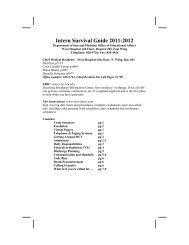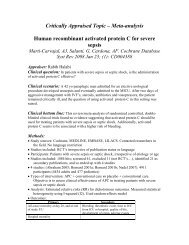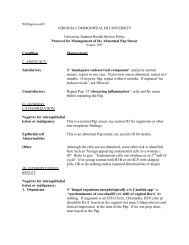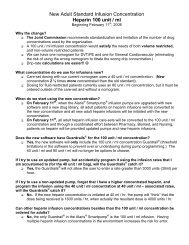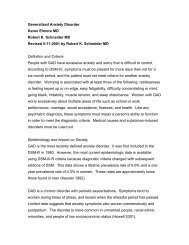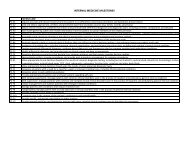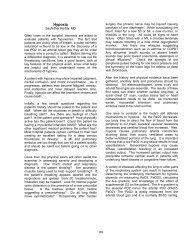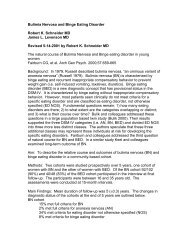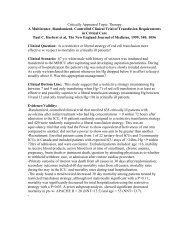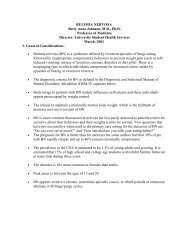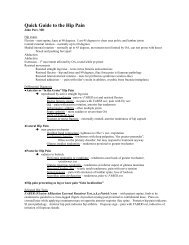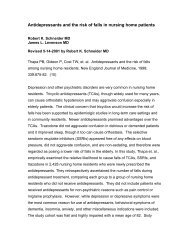A case-control study of lung cancer screening in Okayama ...
A case-control study of lung cancer screening in Okayama ...
A case-control study of lung cancer screening in Okayama ...
Create successful ePaper yourself
Turn your PDF publications into a flip-book with our unique Google optimized e-Paper software.
Lung Cancer 34 (2001) 325–332www.elsevier.com/locate/<strong>lung</strong>canA <strong>case</strong>-<strong>control</strong> <strong>study</strong> <strong>of</strong> <strong>lung</strong> <strong>cancer</strong> <strong>screen<strong>in</strong>g</strong> <strong>in</strong> <strong>Okayama</strong>Prefecture, JapanKenji Nishii a, *, Hiroshi Ueoka b , Katsuyuki Kiura b , Tsuyoshi Kodani a ,Masahiro Tabata b , Takuo Shibayama b , Kenichi Gemba a , Takushi Kitajima b ,Akio Hiraki b , Masashi Kawaraya a , Tomio Nakayama c , M<strong>in</strong>e Harada aaDepartment <strong>of</strong> Respiratory Medic<strong>in</strong>e, <strong>Okayama</strong> Institute <strong>of</strong> Health and Preention, 408-1 Hirata, <strong>Okayama</strong> 700-0952, JapanbDepartment <strong>of</strong> Internal Medic<strong>in</strong>e II, <strong>Okayama</strong> Uniersity Medical School, <strong>Okayama</strong>, JapancDiision <strong>of</strong> Epidemiology, Department <strong>of</strong> Field Research, Osaka Medical Center for Cancer and Cardioascular Diseases,Osaka, JapanReceived 8 March 2001; received <strong>in</strong> revised form 15 June 2001; accepted 18 June 2001AbstractThe effectiveness <strong>of</strong> <strong>lung</strong> <strong>cancer</strong> <strong>screen<strong>in</strong>g</strong> <strong>in</strong> reduc<strong>in</strong>g mortality still rema<strong>in</strong>s uncerta<strong>in</strong>. In order to evaluate theefficacy <strong>of</strong> <strong>lung</strong> <strong>cancer</strong> <strong>screen<strong>in</strong>g</strong>, a <strong>case</strong>-<strong>control</strong> <strong>study</strong> was conducted <strong>in</strong> <strong>Okayama</strong> Prefecture, Japan. The <strong>study</strong> areaconsisted <strong>of</strong> 34 municipalities where a population-based <strong>lung</strong> <strong>cancer</strong> <strong>screen<strong>in</strong>g</strong> had been conducted. Chest X-rayexam<strong>in</strong>ations for all participants and sputum cytology for high-risk participants were <strong>of</strong>fered annually. The <strong>case</strong>sanalyzed <strong>in</strong> this <strong>study</strong> consisted <strong>of</strong> 412 <strong>in</strong>dividuals aged between 40 and 79 who died <strong>of</strong> <strong>lung</strong> <strong>cancer</strong>. A total <strong>of</strong> 3490<strong>control</strong>s, two to ten for each <strong>case</strong> matched by gender, year <strong>of</strong> birth, and liv<strong>in</strong>g district were randomly collected.Screen<strong>in</strong>g histories <strong>of</strong> <strong>case</strong>s were compared with those <strong>of</strong> and matched <strong>control</strong>s for the identical calendar period prioto diagnosis <strong>of</strong> the <strong>case</strong>. Smok<strong>in</strong>g adjusted odds ratio (OR) <strong>of</strong> death from <strong>lung</strong> <strong>cancer</strong> for screened <strong>in</strong>dividuals versusunscreened, with<strong>in</strong> 12 months before diagnosis, was calculated as 0.59 (95% confidence <strong>in</strong>terval: 0.46–0.74;P=0.0001). The OR for women (0.39, 95% confidence <strong>in</strong>terval: 0.24–0.64) was lower than that for men (0.67, 95%confidence <strong>in</strong>terval: 0.51–0.87), although both were statistically significant. These results suggest that <strong>lung</strong> <strong>cancer</strong><strong>screen<strong>in</strong>g</strong> contributes to reduc<strong>in</strong>g <strong>lung</strong> <strong>cancer</strong> mortality by 41%. © 2001 Elsevier Science Ireland Ltd. All rightsreserved.Keywords: Case-<strong>control</strong> <strong>study</strong>; Chest X-ray exam<strong>in</strong>ation; Lung <strong>cancer</strong> mortality; Lung <strong>cancer</strong> <strong>screen<strong>in</strong>g</strong>; Odds ratio; Sputumcytology1. Introduction* Correspond<strong>in</strong>g author. Tel.: +81-86-224-3258; fax: +81-86-224-3250.E-mail address: nkenji@lime.ocn.ne.jp (K. Nishii).The ideal sett<strong>in</strong>g to assess a <strong>cancer</strong> <strong>screen<strong>in</strong>g</strong>program is a randomized <strong>control</strong>led trial [1]. Forevaluation <strong>of</strong> <strong>lung</strong> <strong>cancer</strong> <strong>screen<strong>in</strong>g</strong>, four randomized<strong>control</strong>led trials <strong>in</strong> the 1970s–1980s failed to0169-5002/01/$ - see front matter © 2001 Elsevier Science Ireland Ltd. All rights reserved.PII: S0169-5002(01)00270-7
326K. Nishii et al. / Lung Cancer 34 (2001) 325–332demonstrate that <strong>screen<strong>in</strong>g</strong> reduced mortalityfrom <strong>lung</strong> <strong>cancer</strong> [2–5]. Therefore the AmericanCancer Society decided not to recommend anytest for early detection <strong>of</strong> <strong>lung</strong> <strong>cancer</strong> [6]. Furthermore,<strong>in</strong> a recent article analyz<strong>in</strong>g the long-termfollow-up results <strong>of</strong> the Mayo Cl<strong>in</strong>ic trial, therewas no significant reduction <strong>of</strong> mortality <strong>in</strong> thegroup receiv<strong>in</strong>g <strong>lung</strong> <strong>cancer</strong> <strong>screen<strong>in</strong>g</strong> [7]. However,the results do not reflect recent advances <strong>in</strong>the diagnostic and therapeutic modalities <strong>of</strong> <strong>lung</strong><strong>cancer</strong>. The Memorial Sloan–Ketter<strong>in</strong>g andJohns–Hopk<strong>in</strong>s Lung Project compared a comb<strong>in</strong>ation<strong>of</strong> annual chest X-ray and sputum cytologywith chest X-ray only. The Mayo LungProject and the Czechoslovak Study comparedfrequent <strong>screen<strong>in</strong>g</strong> with sporadic <strong>screen<strong>in</strong>g</strong>.Thus none <strong>of</strong> the four studies evaluated the efficacy<strong>of</strong> annual <strong>lung</strong> <strong>cancer</strong> <strong>screen<strong>in</strong>g</strong> <strong>in</strong> comparisonwith no <strong>screen<strong>in</strong>g</strong> [8]. Now, a large-scalemultiphase <strong>screen<strong>in</strong>g</strong> trial (PLCO Cancer Screen<strong>in</strong>gTrial) sponsored by the National Cancer Instituteis go<strong>in</strong>g on <strong>in</strong> the US, but the results <strong>of</strong> the<strong>study</strong> are not expected to be published before2010.A <strong>case</strong>-<strong>control</strong> <strong>study</strong> is another method to evaluate<strong>cancer</strong> <strong>screen<strong>in</strong>g</strong> [9,10]. In fact, this approachhas been applied <strong>in</strong> the evaluation <strong>of</strong> <strong>screen<strong>in</strong>g</strong> forcervical <strong>cancer</strong>, breast <strong>cancer</strong>, gastric <strong>cancer</strong>, andcolorectal <strong>cancer</strong> [11–14]. Screen<strong>in</strong>g for <strong>lung</strong> <strong>cancer</strong>has already been evaluated us<strong>in</strong>g <strong>case</strong>-<strong>control</strong>studies <strong>in</strong> East Berl<strong>in</strong> [15] and <strong>in</strong> Japan [16,17].However, s<strong>in</strong>ce the odds ratios <strong>of</strong> death from <strong>lung</strong><strong>cancer</strong> for screened <strong>in</strong>dividuals versus unscreened<strong>in</strong> these studies were <strong>in</strong>consistent (0.54–1.1), conclusiveresults have not yet been obta<strong>in</strong>ed.In <strong>Okayama</strong> Prefecture, Japan, a <strong>lung</strong> <strong>cancer</strong><strong>screen<strong>in</strong>g</strong> program was conducted from 1976through 1986 as a pilot <strong>study</strong> [18], which showedthe possible efficacy <strong>of</strong> mass <strong>screen<strong>in</strong>g</strong> for <strong>lung</strong><strong>cancer</strong>. The <strong>screen<strong>in</strong>g</strong> program was supported bythe national government under the Health andMedical Services Law for the Aged s<strong>in</strong>ce 1987,and a total <strong>of</strong> 2 323 455 <strong>in</strong>dividuals were screenedbetween 1987 and 1998 <strong>in</strong> <strong>Okayama</strong> Prefecture.N<strong>in</strong>e hundred and sixty <strong>case</strong>s with <strong>lung</strong><strong>cancer</strong> were detected and 65.8% <strong>of</strong> them couldbe surgically resected. In order to evaluate theefficacy <strong>of</strong> <strong>lung</strong> <strong>cancer</strong> <strong>screen<strong>in</strong>g</strong> <strong>in</strong> <strong>Okayama</strong>Prefecture, Japan, we conducted a <strong>case</strong>-<strong>control</strong><strong>study</strong>.2. Methods2.1. Mass <strong>screen<strong>in</strong>g</strong> for <strong>lung</strong> <strong>cancer</strong> <strong>in</strong> the <strong>study</strong>areaThe <strong>study</strong> area consisted <strong>of</strong> 34 cities, villages,and towns <strong>in</strong> <strong>Okayama</strong> Prefecture where we havebeen conduct<strong>in</strong>g <strong>lung</strong> <strong>cancer</strong> <strong>screen<strong>in</strong>g</strong> and couldutilize the computerized records <strong>of</strong> people whowere <strong>in</strong>vited to the <strong>screen<strong>in</strong>g</strong>. This <strong>study</strong> wasconducted between 1991 and 1996. The beg<strong>in</strong>n<strong>in</strong>g<strong>of</strong> the <strong>study</strong> period varied accord<strong>in</strong>g to the yearswhen the records were computerized <strong>in</strong> each area:four municipalities <strong>in</strong> 1991, 12 <strong>in</strong> 1992, 13 <strong>in</strong> 1993,three <strong>in</strong> 1994, and one each at 1995 and 1996.The Tuberculosis Control Law required allJapanese citizens aged 16 or over to have anannual chest X-ray exam<strong>in</strong>ation s<strong>in</strong>ce the 1950s.Lung <strong>cancer</strong> <strong>screen<strong>in</strong>g</strong> programs have been addedto the system s<strong>in</strong>ce 1987, for <strong>in</strong>dividuals aged 40or over, under the Health and Medical ServicesLaw for the Aged. People who were <strong>in</strong>vited to the<strong>screen<strong>in</strong>g</strong> were all National Health Insuranceholders or family members <strong>of</strong> Employment-relatedHealth Insurance, because the EmploymentrelatedHealth Insurance holders themselves wereassigned to be screened <strong>in</strong> their companies undera different system.An annual chest X-ray exam<strong>in</strong>ation was conductedfor all screenees us<strong>in</strong>g 100×100 mmm<strong>in</strong>iature phot<strong>of</strong>luorography with tube voltage <strong>of</strong>140 kV. Smok<strong>in</strong>g habits <strong>of</strong> all screenees wererecorded. Sputum cytology with Saccomanno’s3-day pooled method was performed for the <strong>in</strong>dividuals<strong>in</strong> the high-risk group. The high-riskgroup was def<strong>in</strong>ed as <strong>in</strong>dividuals aged 50 or overwith a smok<strong>in</strong>g <strong>in</strong>dex (average number <strong>of</strong>cigarettes smoked per day multiplied by the number<strong>of</strong> years smoked) <strong>of</strong> at least 600 and <strong>in</strong>dividualsaged 40 or over with a history <strong>of</strong> bloodysputum. For the <strong>in</strong>dividuals suspected to have<strong>lung</strong> <strong>cancer</strong> by chest X-ray or sputum cytology,further exam<strong>in</strong>ations were performed to confirmthe diagnosis.
K. Nishii et al. / Lung Cancer 34 (2001) 325–332 3272.2. Source populationThe source population <strong>of</strong> this <strong>study</strong> was def<strong>in</strong>edas people who were resident <strong>in</strong> the <strong>study</strong> area andwere <strong>in</strong>vited to the <strong>screen<strong>in</strong>g</strong> at least once dur<strong>in</strong>gthe <strong>study</strong> period. Information about all the peoplewho were <strong>in</strong>vited to the <strong>screen<strong>in</strong>g</strong> were preservedas computerized records. A total <strong>of</strong> 247 537 people(110 035 men and 137 502 women) were thesource population. Table 1 shows the distribution<strong>of</strong> age and gender <strong>in</strong> the population. Attendancerates <strong>in</strong> 1997 are also shown on Table 1. Attendancerates for men were lower than those forwomen and attendance rates were generally higher<strong>in</strong> elderly people.2.3. Case identificationThe <strong>case</strong>s analyzed <strong>in</strong> the present <strong>study</strong> weredef<strong>in</strong>ed as the residents <strong>in</strong> the <strong>study</strong> area who died<strong>of</strong> <strong>lung</strong> <strong>cancer</strong> dur<strong>in</strong>g the <strong>study</strong> period, at an agebetween 40 and 79. Data on diagnosis were obta<strong>in</strong>edfrom the hospital records and/or from the<strong>Okayama</strong> Cancer Registry. Data on smok<strong>in</strong>ghabits were obta<strong>in</strong>ed from the Registry, hospitalrecords, or previous <strong>screen<strong>in</strong>g</strong> records. When anydiscrepancies concern<strong>in</strong>g smok<strong>in</strong>g <strong>in</strong>dex were observed,the highest number was used for theanalyses. Histologic types were classified accord<strong>in</strong>gto the World Health Organization histologicclassification [19].There were 1154 deaths from <strong>lung</strong> <strong>cancer</strong> <strong>in</strong> the34 municipalities dur<strong>in</strong>g the <strong>study</strong> period, accord<strong>in</strong>gto the death certificates <strong>of</strong> all residents. Ofthose, 371 had been over 79 years old and five hadbeen under 40 years old at the time <strong>of</strong> death, andthey were excluded. Fifty-eight <strong>case</strong>s had not undergone<strong>screen<strong>in</strong>g</strong> dur<strong>in</strong>g the <strong>study</strong> period andwere excluded. Data on the diagnosis <strong>of</strong> the rema<strong>in</strong><strong>in</strong>g720 <strong>case</strong>s were exam<strong>in</strong>ed at the <strong>Okayama</strong>Cancer Registry. Lung <strong>cancer</strong> had been diagnosedbefore the beg<strong>in</strong>n<strong>in</strong>g <strong>of</strong> the <strong>study</strong> period <strong>in</strong> 223and they were excluded. S<strong>in</strong>ce 72 <strong>case</strong>s had beendiagnosed and had died <strong>in</strong> other prefectures,where the <strong>Okayama</strong> Cancer Registry was unableto collect appropriate <strong>in</strong>formation, these <strong>case</strong>swere excluded. Eight <strong>case</strong>s were excluded becausethe dates <strong>of</strong> diagnosis were unable to be confirmeddue to the physician’s refusal or loss <strong>of</strong>medical records. Five <strong>case</strong>s were excluded becausethe true diagnosis was metastatic <strong>lung</strong> tumor. No<strong>case</strong>s had moved <strong>in</strong> from another municipalitydur<strong>in</strong>g the <strong>study</strong> period. The rema<strong>in</strong><strong>in</strong>g 412 <strong>in</strong>dividualswere f<strong>in</strong>ally enrolled <strong>in</strong> the present <strong>study</strong>as the appropriate <strong>case</strong>s.2.4. Control identificationControl candidacy was limited to <strong>in</strong>dividualswho had been liv<strong>in</strong>g <strong>in</strong> the same area as thecorrespond<strong>in</strong>g <strong>case</strong> from the beg<strong>in</strong>n<strong>in</strong>g <strong>of</strong> the<strong>study</strong> period until the diagnosis <strong>of</strong> the <strong>case</strong>, andTable 1Distribution <strong>of</strong> age and sex <strong>in</strong> the <strong>study</strong> population and attendance rate <strong>of</strong> <strong>screen<strong>in</strong>g</strong> <strong>in</strong> 1997Number <strong>of</strong> <strong>study</strong> population Screened <strong>in</strong> 1997Attendance rate <strong>in</strong> 1997 (%)Male Female MaleFemale Male Female40–44 11 90814 6078804318 7.429.645–49 15 090 18 091 13846190 9.2 34.250–54 15 283 18 686 148862399.733.455–59 13 287 17 069 16466617 12.438.860–64 14 331 17 6354252 9065 29.7 51.465–69 16 144 19 2886316 10 333 39.1 53.670–74 14 57617 6335844839540.147.675–79 941614 493 3305 5268 35.1 36.380– 14 110 23 7852829390020.016.4Total 110 035137 502 25 11556 425
328K. Nishii et al. / Lung Cancer 34 (2001) 325–332had undergone <strong>screen<strong>in</strong>g</strong>. Six to ten <strong>in</strong>dividualsfor each <strong>case</strong>, who were matched by gender, year<strong>of</strong> birth (with<strong>in</strong> 2 years), and liv<strong>in</strong>g district, wereselected as <strong>control</strong>s from the computerizedrecords. Then, a total <strong>of</strong> 3756 people (2996 menand 760 women) were selected as <strong>control</strong>candidates.Of those, 17 were excluded because <strong>of</strong> mov<strong>in</strong>g<strong>in</strong>to the district after the diagnosis <strong>of</strong> the correspond<strong>in</strong>g<strong>case</strong>, and another 17 were excludedbecause they had died or migrated to other areasbefore the <strong>case</strong> was diagnosed. For the rema<strong>in</strong><strong>in</strong>g3722 <strong>in</strong>dividuals (2966 men and 756 women),smok<strong>in</strong>g habits were surveyed us<strong>in</strong>g previous<strong>screen<strong>in</strong>g</strong> records or mailed questionnaires. Whenthere was no response to a mailed questionnaire, apublic health nurse conducted an <strong>in</strong>terviewby telephone or home visit. If the <strong>control</strong> candidatewas deceased or ill, a family member was<strong>in</strong>terviewed. Regardless <strong>of</strong> the <strong>in</strong>terview method,<strong>in</strong>formed consent was obta<strong>in</strong>ed before the <strong>in</strong>terviewwith promised nondisclosure <strong>of</strong> private <strong>in</strong>formation.Information on smok<strong>in</strong>g habits wasobta<strong>in</strong>ed for 3490 <strong>in</strong>dividuals (93.7%). The smok<strong>in</strong>g<strong>in</strong>dex <strong>of</strong> the <strong>control</strong> was calculated for theperiod up to the diagnosis <strong>of</strong> the correspond<strong>in</strong>g<strong>case</strong>.F<strong>in</strong>ally, 412 <strong>case</strong>s and 3490 <strong>control</strong>s were selectedfor the analysis. The <strong>case</strong>-<strong>control</strong> sets <strong>in</strong>cludedone set with two <strong>control</strong>s, six sets withfour <strong>control</strong>s, ten sets with five <strong>control</strong>s, 46 setswith six <strong>control</strong>s, 35 sets with seven <strong>control</strong>s, 64sets with eight <strong>control</strong>s, 119 sets with n<strong>in</strong>e <strong>control</strong>s,and 131 sets with ten <strong>control</strong>s.2.5. Screen<strong>in</strong>g historyScreen<strong>in</strong>g histories <strong>of</strong> the <strong>case</strong>s and <strong>control</strong>swere obta<strong>in</strong>ed from the lists <strong>of</strong> screenees.Screen<strong>in</strong>g histories were traced back for the identicalcalendar period 36 months before the diagnosis<strong>of</strong> <strong>lung</strong> <strong>cancer</strong> <strong>in</strong> the <strong>case</strong>. The <strong>screen<strong>in</strong>g</strong>,which led to the diagnosis <strong>of</strong> <strong>lung</strong> <strong>cancer</strong>, was<strong>in</strong>cluded <strong>in</strong> the <strong>screen<strong>in</strong>g</strong> history. S<strong>in</strong>ce we had no<strong>in</strong>formation about the chances <strong>of</strong> tak<strong>in</strong>g chestX-rays outside the <strong>lung</strong> <strong>cancer</strong> <strong>screen<strong>in</strong>g</strong>, only<strong>screen<strong>in</strong>g</strong> history <strong>in</strong> the mass <strong>screen<strong>in</strong>g</strong> wascounted.2.6. AnalysesOdds ratios <strong>of</strong> death from <strong>lung</strong> <strong>cancer</strong> for thescreened <strong>in</strong>dividuals versus unscreened were analyzed.Conditional logistic regression models wereused to estimate odds ratios and their 95% confidence<strong>in</strong>tervals (95% CIs). Smok<strong>in</strong>g adjusted oddsratios were calculated <strong>in</strong>clud<strong>in</strong>g eight variables(1–399, 400–599, 600–799, 800–999, 1000–1199,1200–1399, 1400–1599, 1600-) on smok<strong>in</strong>g <strong>in</strong>dex.In order to evaluate the effect <strong>of</strong> the <strong>screen<strong>in</strong>g</strong><strong>in</strong>terval, the ma<strong>in</strong> exposure variable was determ<strong>in</strong>edto be a visit <strong>in</strong> the last 12 months. Statisticalsignificance was assessed at the 5% level, and a95% CI for odds ratio was presented. ThePHREG Procedure <strong>of</strong> the SAS program was usedfor this analysis.3. ResultsTable 2 shows the characteristics <strong>of</strong> the <strong>case</strong>s.Three-quarters <strong>of</strong> the total <strong>case</strong>s were men andalmost 90% <strong>of</strong> the <strong>case</strong>s were 60 years old or over.The appearance <strong>of</strong> symptoms was the most frequentcause <strong>of</strong> detection for deceased <strong>case</strong>s. Adenocarc<strong>in</strong>omawas the most common histologictype <strong>in</strong> both men and women, although the histologictype could not be confirmed <strong>in</strong> 24.3% <strong>of</strong> menand 27.5% <strong>of</strong> women.Table 3 shows the distribution <strong>of</strong> smok<strong>in</strong>g <strong>in</strong>dexfor <strong>case</strong>s and <strong>control</strong>s. Smok<strong>in</strong>g <strong>in</strong>dexes <strong>of</strong>the male <strong>case</strong>s were significantly higher (P=0.001) than those <strong>of</strong> the <strong>control</strong>s.These results are similar to those <strong>in</strong> the cl<strong>in</strong>icbased<strong>case</strong>-<strong>control</strong> <strong>study</strong> <strong>in</strong> Japan [16].Table 4 shows the odds ratios <strong>of</strong> death from<strong>lung</strong> <strong>cancer</strong> with<strong>in</strong> 12 months before diagnosis.S<strong>in</strong>ce there was deviation <strong>of</strong> the smok<strong>in</strong>g <strong>in</strong>dexbetween <strong>case</strong>s and <strong>control</strong>s, the odds ratios wereadjusted by smok<strong>in</strong>g <strong>in</strong>dexes with a logistic regressionmodel. The smok<strong>in</strong>g-adjusted odds ratio<strong>of</strong> death from <strong>lung</strong> <strong>cancer</strong> with<strong>in</strong> 12 months beforediagnosis for those screened versus unscreenedwas 0.59 (95% CI: 0.46–0.74), whichdemonstrated a statistical significance (P=0.0001). The odds ratio for women (0.39, 95% CI:0.24–0.64) was lower than that for men (0.67,
K. Nishii et al. / Lung Cancer 34 (2001) 325–332 329Table 2Characteristics <strong>of</strong> the <strong>case</strong>sMale (%) Female (%)Age40–44 3 (0.9) 2 (2.2)45–4910 (3.1) 3(3.3)50–54 5(1.6) 4(4.4)55–5916 (5.0) 5(5.5)60–64 36 (11.2)11(12.1)65–6986 (26.8) 19(20.9)70–74 85(26.5) 27 (29.7)75–79 80(24.9) 20 (22.0)Cause <strong>of</strong> detectionScreen<strong>in</strong>g 26(8.1) 7 (7.7)Other health checkup2 (0.6) 0(0.0)Symptom 93(29.0) 32(35.2)Other disease44 (13.7) 4(4.4)Other reason 1 (0.3)2 (2.2)UnknownHistologic typeSquamous cell carc<strong>in</strong>oma15587(48.3)(27.1)465(50.6)(5.5)Adenocarc<strong>in</strong>oma105 (32.2) 47(51.7)Small cell carc<strong>in</strong>oma 43(13.4) 9 (9.9)Large cell carc<strong>in</strong>oma7 (2.2) 5(5.5)Other 1(0.3) 0(0.0)Unknown78 (24.3) 25(27.5)Total 3219195% CI: 0.51–0.87), although both had statisticalsignificance.S<strong>in</strong>ce the <strong>control</strong> candidates who did not respondto the smok<strong>in</strong>g survey had a low attendancerate <strong>of</strong> <strong>screen<strong>in</strong>g</strong> (3.8%), probably due to alow level <strong>of</strong> concern with health, exclusion <strong>of</strong>these from the analysis might lead to overestimation<strong>of</strong> the efficacy <strong>of</strong> the <strong>screen<strong>in</strong>g</strong>. Thereforesmok<strong>in</strong>g <strong>in</strong>dex derived from the median <strong>of</strong> other<strong>control</strong>s (660 for men, 0 for women) were assignedto the 232 nonrespondents, and analyseswere performed for a total <strong>of</strong> 3722 <strong>control</strong>s (Table5). The smok<strong>in</strong>g-adjusted odds ratio <strong>of</strong> deathfrom <strong>lung</strong> <strong>cancer</strong>, 0.64 (95% CI: 0.51–0.81, P=0.0002), was somewhat closer to 1.0, but still hadstatistical significance.4. DiscussionIn a population based <strong>case</strong>-<strong>control</strong> <strong>study</strong> <strong>of</strong><strong>lung</strong> <strong>cancer</strong> <strong>screen<strong>in</strong>g</strong> conducted <strong>in</strong> 50 municipalities<strong>in</strong> Japan, Sobue et al. suggested that annual<strong>screen<strong>in</strong>g</strong> could reduce the risk <strong>of</strong> death from <strong>lung</strong><strong>cancer</strong> by a maximum <strong>of</strong> 28% (odds ratio 0.72,95% CI: 0.50–1.03) [16]. However, their resultshad only marg<strong>in</strong>al significance (P=0.07). On theother hand, <strong>in</strong> this <strong>study</strong>, we demonstrated thestatistically significant efficacy <strong>of</strong> populationbasedannual <strong>screen<strong>in</strong>g</strong> to reduce the risk <strong>of</strong> deathfrom <strong>lung</strong> <strong>cancer</strong>.The odds ratio <strong>in</strong> this <strong>study</strong> was lower than that<strong>in</strong> Sobue’s report [16], which may be expla<strong>in</strong>ed <strong>in</strong>part by improvement <strong>in</strong> the sensitivity <strong>of</strong> chestX-ray exam<strong>in</strong>ations. In Sobue’s report, somechest X-ray exam<strong>in</strong>ations were taken with lowvoltageexposure (90 kV tube voltage), whereasonly high-voltage exposure (140 kV) were used <strong>in</strong>the present <strong>study</strong>. Although the calculat<strong>in</strong>g methodswere different, the sensitivity <strong>of</strong> chest X-raywith high-voltage exposure was reported as 70%(Nagasaki Study [20], conducted <strong>in</strong> 1987–1989),while that <strong>in</strong> a previous <strong>study</strong> <strong>in</strong>clud<strong>in</strong>g lowvoltageexposure, was 56.8% (Osaka Study [21],
330K. Nishii et al. / Lung Cancer 34 (2001) 325–332conducted <strong>in</strong> 1981–1985). This difference <strong>in</strong> sensitivitymay have affected the odds ratio.The efficacy to reduce the risk <strong>of</strong> death wasprom<strong>in</strong>ent <strong>in</strong> women compared with that <strong>in</strong> men,which was consistent with the results previouslyreported by Sobue et al [16]. These results mayreflect that a majority <strong>of</strong> <strong>lung</strong> <strong>cancer</strong> <strong>in</strong> women isperipheral type adenocarc<strong>in</strong>oma, which are easilydetectable by chest X-ray, when good quality<strong>control</strong> was achieved. In the present <strong>study</strong>, the<strong>in</strong>cidence <strong>of</strong> <strong>screen<strong>in</strong>g</strong> as a cause <strong>of</strong> detection wasmarkedly low, which may suggest the favorableresults for <strong>screen<strong>in</strong>g</strong> (low risk <strong>of</strong> death <strong>in</strong> thepatients detected by mass <strong>screen<strong>in</strong>g</strong>).There are several methodological issues <strong>in</strong>volved<strong>in</strong> this <strong>study</strong>, which need to be discussed[22]. First, the time <strong>of</strong> beg<strong>in</strong>n<strong>in</strong>g <strong>of</strong> the <strong>study</strong>differed from place to place due to variation <strong>in</strong> theyears when records <strong>of</strong> the <strong>screen<strong>in</strong>g</strong> were available<strong>in</strong> each area. However, s<strong>in</strong>ce we rigorously selectedthe matched <strong>control</strong>s <strong>in</strong> each locality, theyhad exactly equal opportunities for <strong>screen<strong>in</strong>g</strong>.Second, s<strong>in</strong>ce we excluded <strong>case</strong> candidateswhose diagnosis preceded the beg<strong>in</strong>n<strong>in</strong>g <strong>of</strong> the<strong>study</strong> period, <strong>case</strong>s were restricted to those with arelatively short <strong>in</strong>terval between diagnosis anddeath. For that reason, our evaluation <strong>of</strong> <strong>screen<strong>in</strong>g</strong>efficacy might be overestimated [23].Third, several <strong>in</strong>vestigators recommended thatthe <strong>screen<strong>in</strong>g</strong> visits with symptoms should not becounted as screened [24]. In the present <strong>study</strong>,although screenees had been asked at the <strong>screen<strong>in</strong>g</strong>visit whether he/she had a history <strong>of</strong> bloodysputum or not, the <strong>in</strong>formation had not beenappropriately preserved. Other <strong>in</strong>formation onsymptoms was also unavailable. Therefore, all <strong>of</strong>the <strong>screen<strong>in</strong>g</strong> visits were counted as screened <strong>in</strong>this <strong>study</strong>, and the results might beunderestimated.Fourth, different techniques were used to obta<strong>in</strong>the smok<strong>in</strong>g histories <strong>of</strong> the <strong>case</strong>s and <strong>control</strong>s.For the <strong>case</strong>s, data were collected from theregistry, hospital records, or previous <strong>screen<strong>in</strong>g</strong>records, while they were obta<strong>in</strong>ed for the <strong>control</strong>sfrom previous <strong>screen<strong>in</strong>g</strong> records or <strong>in</strong>terviews(mail, telephone or home visit), which may havecaused some bias <strong>in</strong> the results. However, thequestionnaires for both <strong>case</strong>s and <strong>control</strong>s werethe same, consist<strong>in</strong>g <strong>of</strong> smok<strong>in</strong>g status, the age <strong>of</strong>start<strong>in</strong>g smok<strong>in</strong>g, number <strong>of</strong> cigarettes smoked <strong>in</strong>a day, and the age <strong>of</strong> stopp<strong>in</strong>g smok<strong>in</strong>g. Furthermore,it was reported previously <strong>in</strong> Japan that thedifference <strong>in</strong> the method used to obta<strong>in</strong> smok<strong>in</strong>ghistories did not significantly cause bias <strong>in</strong> theresults [25]. The Japanese prevalences <strong>of</strong> smok<strong>in</strong>g<strong>in</strong> 1998 were 50.8% <strong>in</strong> male and 10.9% <strong>in</strong> femaleaccord<strong>in</strong>g to the homepage <strong>of</strong> the Japanese M<strong>in</strong>istry<strong>of</strong> Health, Labour and Welfare. The prevalences<strong>in</strong> the present <strong>study</strong> were lower <strong>in</strong> malesand higher <strong>in</strong> females, which may be attributableto exclusion <strong>of</strong> young adults (less than 40 yearsold) <strong>in</strong> the present <strong>study</strong>.Table 3Smok<strong>in</strong>g <strong>in</strong>dex <strong>of</strong> <strong>case</strong>s and <strong>control</strong>sSmok<strong>in</strong>g <strong>in</strong>dexCasesControlsMale a (%) Female (%) Male a (%) Female (%)045 (14.0) 81(89.0) 708 (25.4) 681 (97.2)1–399 8 (2.5) 2 (2.2) 237 (8.5) 7 (1.0)400–599 37 (11.5) 2 (2.2) 320 (11.5) 6(0.9)600–799 31 (9.7) 2 (2.2) 298 (10.7) 2(0.3)800–999 59 (18.4) 0 (0.0) 413 (14.8) 2 (0.3)1000–1199 80 (24.9) 2 (2.2) 408 (14.6) 1 (0.1)1200–1399 27 (8.4) 1(1.1) 175 (6.3) 0(0.0)1400–1599 9 (2.8) 1 (1.1) 69 (2.5) 0 (0.0)1600- 25 (7.8) 0(0.0) 161 (5.8) 2(0.3)Total321 (100.0) 91(100.0) 2789 (100.0) 701 (100.0)a Smok<strong>in</strong>g <strong>in</strong>dex <strong>of</strong> male <strong>case</strong>s are significantly higher (P=0.001) than those <strong>of</strong> male <strong>control</strong>s.
K. Nishii et al. / Lung Cancer 34 (2001) 325–332 331Table 4Odds ratios <strong>of</strong> death from <strong>lung</strong> <strong>cancer</strong> for <strong>in</strong>dividuals screened with<strong>in</strong> 12 monthsGenderNumber <strong>of</strong>Screened (%)OR a95% CI bCasesControls Cases ControlsTotal 412 3490 32.3 43.9 0.59 0.46–0.74Male 3212789 32.4 42.1 0.67 0.51–0.87Female91 701 31.9 51.2 0.390.24–0.64a OR: Odds ratio.b95% CI: 95% confidence <strong>in</strong>terval.Fifth, <strong>in</strong> this <strong>study</strong>, smok<strong>in</strong>g history was notmatched <strong>in</strong> <strong>case</strong>s with <strong>control</strong>s. S<strong>in</strong>ce this mightlead to lower precision <strong>in</strong> <strong>case</strong>-<strong>control</strong> comparison,we used multivariate analysis with a smok<strong>in</strong>g<strong>in</strong>dex to compensate bias with respect to smok<strong>in</strong>g.Furthermore, we also performed additional smok<strong>in</strong>g-matchedanalyses by exclud<strong>in</strong>g smok<strong>in</strong>g-unmatched<strong>control</strong>s (eg exclud<strong>in</strong>g high-risk male<strong>control</strong>s for a non-high-risk male <strong>case</strong>, and so on).Of 3490 <strong>control</strong>s, 1603 were excluded becausesmok<strong>in</strong>g habits were not matched, and 11 <strong>of</strong> 412<strong>case</strong>s were also excluded because they did nothave any appropriate <strong>control</strong>s. For 401 <strong>case</strong>s and1887 <strong>control</strong>s, odds ratio <strong>of</strong> the smok<strong>in</strong>g-matchedanalysis was 0.55 (95% CI: 0.43–0.70). This resultrevealed that statistical significance was consistentregardless <strong>of</strong> the match<strong>in</strong>g <strong>of</strong> smok<strong>in</strong>g habits.The 232 nonrespondents to the smok<strong>in</strong>g survey<strong>of</strong> 3722 <strong>control</strong> candidates were excluded from thema<strong>in</strong> analyses <strong>of</strong> this <strong>study</strong>. S<strong>in</strong>ce exclusion <strong>of</strong> thenonrespondents creates the possibility <strong>of</strong> overestimat<strong>in</strong>gthe efficacy <strong>of</strong> <strong>screen<strong>in</strong>g</strong>, those 232 <strong>control</strong>candidates were <strong>in</strong>cluded <strong>in</strong> another analysis byassign<strong>in</strong>g their smok<strong>in</strong>g <strong>in</strong>dex as the median <strong>of</strong>the <strong>control</strong>s respond<strong>in</strong>g to smok<strong>in</strong>g survey (660for males, 0 for females). As shown <strong>in</strong> Table 5, theresults revealed that the odds ratio came a bitcloser to 1.0, but statistical significance was stillobta<strong>in</strong>ed.In conclusion, this <strong>case</strong>-<strong>control</strong> <strong>study</strong> suggestedthat annual <strong>lung</strong> <strong>cancer</strong> <strong>screen<strong>in</strong>g</strong> <strong>in</strong> <strong>Okayama</strong>Prefecture, Japan, consist<strong>in</strong>g <strong>of</strong> chest X-ray andsputum cytology, could reduce the <strong>lung</strong> <strong>cancer</strong>mortality by 41% (95% confidence <strong>in</strong>terval: 26–54%). The significant reduction <strong>of</strong> the risk for<strong>lung</strong> <strong>cancer</strong> death was observed both <strong>in</strong> males and<strong>in</strong> females.AcknowledgementsWe would like to thank Dr Suzuki <strong>of</strong> OsakaMedical Center for Cancer and CardiovascularDiseases, and Dr Kawamura <strong>of</strong> the <strong>Okayama</strong>Cancer Registry for data collection. We alsothank Ms Masakage and Ms Tanaka for theirassistance with collection and analysis <strong>of</strong> data.This <strong>study</strong> was supported by Grant-<strong>in</strong>-Aid forTable 5Odds ratios <strong>of</strong> death from <strong>lung</strong> <strong>cancer</strong> for <strong>in</strong>dividuals screened with<strong>in</strong> 12 months: analysis <strong>in</strong>clud<strong>in</strong>g non-respondentsNumber <strong>of</strong>Screened (%)OR b95% CI cCases Controls a CasesControlsTotal 412 372232.341.8 0.640.51–0.81Male 321 296632.1 40.0 0.71 0.55–0.93Female 91 756 31.9 48.8 0.450.28–0.74aAnalysis was performed assign<strong>in</strong>g the median <strong>of</strong> smok<strong>in</strong>g <strong>in</strong>dex (660 for men and 0 for women) to 232 nonrespond<strong>in</strong>g <strong>control</strong>sto smok<strong>in</strong>g survey.b OR: Odds ratio.c 95% CI: 95% confidence <strong>in</strong>terval.
332K. Nishii et al. / Lung Cancer 34 (2001) 325–332Cancer Research from the M<strong>in</strong>istry <strong>of</strong> Health andWelfare, Japan (9–7).References[1] US Preventive Services Task Force. Methodology forreview<strong>in</strong>g evidence: Guide to cl<strong>in</strong>ical preventive services,2nd edn. Williams and Wilk<strong>in</strong>s, Inc., Baltimore, 1996,47-55[2] Fontana RS, Sanderson DR, Woolner LB, et al. Screen<strong>in</strong>gfor <strong>lung</strong> <strong>cancer</strong>: a critique <strong>of</strong> the Mayo Lung Project.Cancer 1991;67:1155–64.[3] Melamed MR, Fleh<strong>in</strong>ger BJ. Detection <strong>of</strong> <strong>lung</strong> <strong>cancer</strong>:Highlights <strong>of</strong> the Memorial Sloan–Ketter<strong>in</strong>g Study <strong>in</strong>New York City. Schweits med Wschr 1987;117:1457–63.[4] Tockman MS. Survival and mortality from <strong>lung</strong> <strong>cancer</strong> <strong>in</strong>screened population: The Johns Hopk<strong>in</strong>s Study. Chest1986;89:324–5.[5] Kubik A, Park<strong>in</strong> DM, Khlat M, et al. Lack <strong>of</strong> benefitfrom semi-annual <strong>screen<strong>in</strong>g</strong> for <strong>cancer</strong> <strong>of</strong> the <strong>lung</strong>: followupreport <strong>of</strong> a randomized <strong>control</strong>led trial on a population<strong>of</strong> high-risk males <strong>in</strong> Czechoslovakia. Int J Cancer1990;45:26–33.[6] American Cancer Society. Report on the <strong>cancer</strong> relatedhealth checkup: <strong>cancer</strong> <strong>of</strong> the <strong>lung</strong>, CA Cancer J. Cl<strong>in</strong>. 30(1980) 199-207.[7] Marcus PM, Bergstralh EJ, Fagerstrom RM, et al. Lung<strong>cancer</strong> mortality <strong>in</strong> the Mayo Lung Project: impact <strong>of</strong>extended follow-up. JNCI 2000;16:1308–16.[8] Strauss GM, Gleason RE, Sugarbaker DJ. Screen<strong>in</strong>g for<strong>lung</strong> <strong>cancer</strong>. Chest 1997;111:754–68.[9] Prorok PC, Chamberla<strong>in</strong> J, Day NE, et al. UICC workshopon the evaluation <strong>of</strong> <strong>screen<strong>in</strong>g</strong> programs for <strong>cancer</strong>.Int J Cancer 1984;34:1–4.[10] Sasco AJ, Day NE, Walter SD. Case-<strong>control</strong> studies forthe evaluation <strong>of</strong> <strong>screen<strong>in</strong>g</strong>. J Chron Dis 1986;39:399–405.[11] Clark EA, Anderson TW. Does <strong>screen<strong>in</strong>g</strong> by ‘PAP’smears help prevent cervical <strong>cancer</strong>? A <strong>case</strong>-<strong>control</strong> <strong>study</strong>.Lancet 1979;II:1–4.[12] Palli D, Roselli DTM, Buiatti E, et al. A <strong>case</strong>-<strong>control</strong><strong>study</strong> <strong>of</strong> the efficacy <strong>of</strong> a non-randomized breast <strong>cancer</strong><strong>screen<strong>in</strong>g</strong> program <strong>in</strong> Florence (Italy). Int J Cancer1986;38:501–4.[13] Oshima A, Hirata N, Ubukata T, et al. Evaluation <strong>of</strong> amass <strong>screen<strong>in</strong>g</strong> program for stomach <strong>cancer</strong> with a <strong>case</strong><strong>control</strong><strong>study</strong> design. Int J Cancer 1986;38:829–33.[14] Selby JV, Friedman GD, Quesenberry CP, et al. A <strong>case</strong><strong>control</strong><strong>study</strong> <strong>of</strong> <strong>screen<strong>in</strong>g</strong> sigmoidoscopy and mortalityfrom colorectal <strong>cancer</strong>. New Eng J Med 1992;326:653–7.[15] Berndt R, Nischan P, Ebel<strong>in</strong>g K. Screen<strong>in</strong>g for <strong>lung</strong><strong>cancer</strong> <strong>in</strong> the middle-aged. Int J Cancer 1990;45:229–30.[16] Sobue T, Suzuki T, Naruke T, et al. A <strong>case</strong>-<strong>control</strong> <strong>study</strong>for evaluat<strong>in</strong>g <strong>lung</strong>-<strong>cancer</strong> <strong>screen<strong>in</strong>g</strong> <strong>in</strong> Japan. Int J Cancer1992;50:230–7.[17] Okamoto N, Suzuki T, Hasegawa H, et al. Evaluation <strong>of</strong>a cl<strong>in</strong>ic-based <strong>screen<strong>in</strong>g</strong> program for <strong>lung</strong> <strong>cancer</strong> with a<strong>case</strong>-<strong>control</strong> design <strong>in</strong> Kanagawa, Japan. Lung Cancer1999;25:77–85.[18] Nishii K. The effectiveness <strong>of</strong> mass <strong>screen<strong>in</strong>g</strong> for <strong>lung</strong><strong>cancer</strong>. <strong>Okayama</strong>-Igakukai-Zashi 1990;102:603–12.[19] World Health Organization. Histological Typ<strong>in</strong>g <strong>of</strong> LungTumors, 2nd edn. World Health Organization, Geneva,1981.[20] Soda H, Tomita H, Kohno S, et al. Limitation <strong>of</strong> annual<strong>screen<strong>in</strong>g</strong> chest radiography for the diagnosis <strong>of</strong> <strong>lung</strong><strong>cancer</strong>: a retrospective <strong>study</strong>. Cancer 1993;72:2341–6.[21] Sobue T, Suzuki T, Matsuda Mm, et al. Sensitivity andspecificity <strong>of</strong> <strong>lung</strong>-<strong>cancer</strong> <strong>screen<strong>in</strong>g</strong> <strong>in</strong> Osaka, Japan. Jpn JCancer Res 1991;82:1069–76.[22] Cron<strong>in</strong> KA, Weed DL, Conner RJ, et al. Case-<strong>control</strong>studies <strong>of</strong> <strong>cancer</strong> <strong>screen<strong>in</strong>g</strong>: theory and practice. J NatlCancer Inst 1998;90:498–504.[23] Weiss NS. Application <strong>of</strong> the <strong>case</strong>-<strong>control</strong> method <strong>in</strong> theevaluation <strong>of</strong> <strong>screen<strong>in</strong>g</strong>. Epidemiol Rev 1994;16:102–8.[24] Weiss NS. Analysis <strong>of</strong> <strong>case</strong>-<strong>control</strong> studies <strong>of</strong> the efficacy<strong>of</strong> <strong>screen<strong>in</strong>g</strong> for <strong>cancer</strong>: how should we deal with testsdone <strong>in</strong> persons with symptoms? Am J Epidemiol1998;147:1099–102.[25] Shimizu H, Hisamichi S. Consistency between the answersfrom husband and wife on questionnaire surveys.Kousei-no-shihyou 1987;34:3–5.



